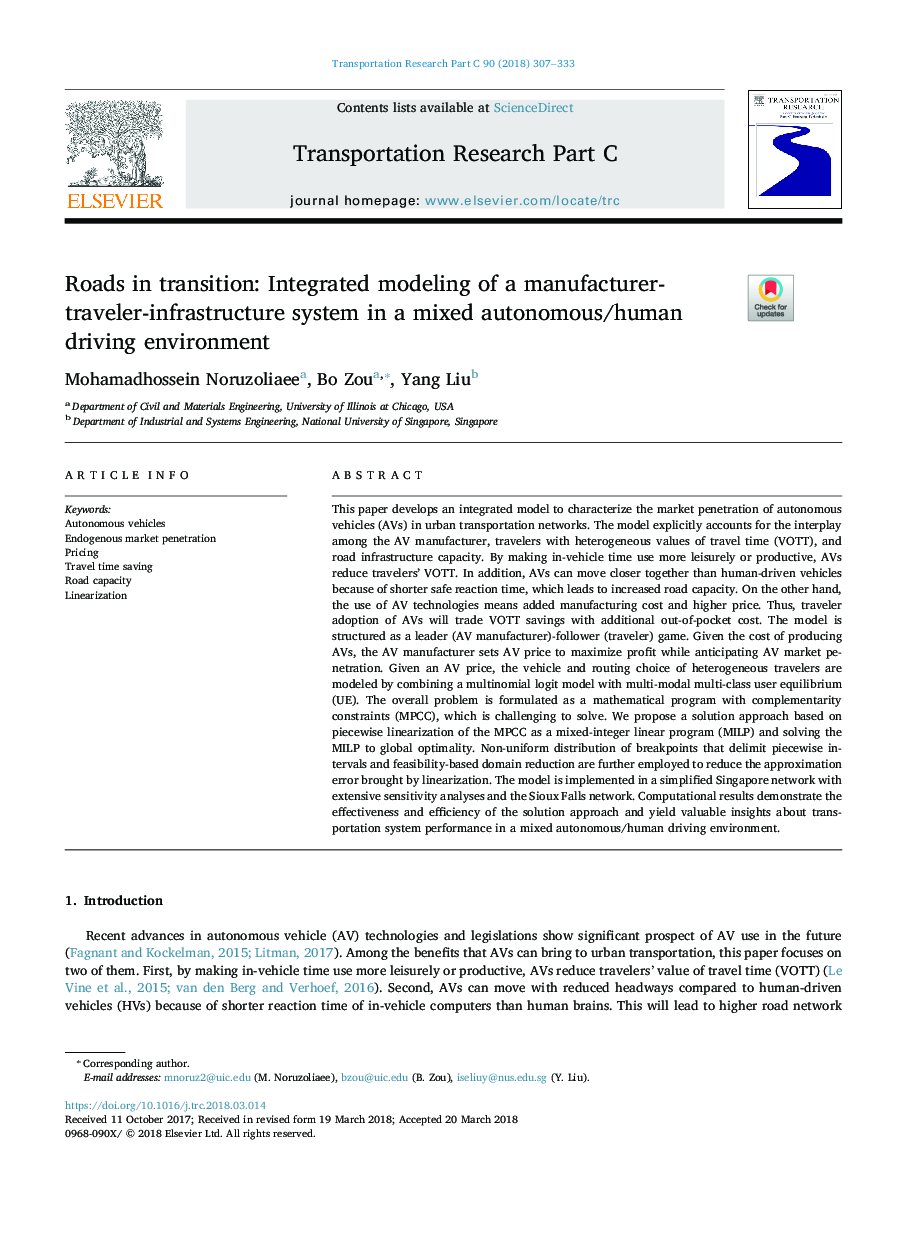| کد مقاله | کد نشریه | سال انتشار | مقاله انگلیسی | نسخه تمام متن |
|---|---|---|---|---|
| 6936014 | 1449658 | 2018 | 27 صفحه PDF | دانلود رایگان |
عنوان انگلیسی مقاله ISI
Roads in transition: Integrated modeling of a manufacturer-traveler-infrastructure system in a mixed autonomous/human driving environment
ترجمه فارسی عنوان
راه های انتقال: مدل سازی مجتمع یک سیستم زیرساخت سازنده مسافر در یک محیط رانندگی مختلط / انسان محور
دانلود مقاله + سفارش ترجمه
دانلود مقاله ISI انگلیسی
رایگان برای ایرانیان
کلمات کلیدی
وسایل نقلیه مستقل، نفوذ بازار درونی، قیمت گذاری، صرفه جویی در زمان سفر ظرفیت جاده، خطی سازی،
موضوعات مرتبط
مهندسی و علوم پایه
مهندسی کامپیوتر
نرم افزارهای علوم کامپیوتر
چکیده انگلیسی
This paper develops an integrated model to characterize the market penetration of autonomous vehicles (AVs) in urban transportation networks. The model explicitly accounts for the interplay among the AV manufacturer, travelers with heterogeneous values of travel time (VOTT), and road infrastructure capacity. By making in-vehicle time use more leisurely or productive, AVs reduce travelers' VOTT. In addition, AVs can move closer together than human-driven vehicles because of shorter safe reaction time, which leads to increased road capacity. On the other hand, the use of AV technologies means added manufacturing cost and higher price. Thus, traveler adoption of AVs will trade VOTT savings with additional out-of-pocket cost. The model is structured as a leader (AV manufacturer)-follower (traveler) game. Given the cost of producing AVs, the AV manufacturer sets AV price to maximize profit while anticipating AV market penetration. Given an AV price, the vehicle and routing choice of heterogeneous travelers are modeled by combining a multinomial logit model with multi-modal multi-class user equilibrium (UE). The overall problem is formulated as a mathematical program with complementarity constraints (MPCC), which is challenging to solve. We propose a solution approach based on piecewise linearization of the MPCC as a mixed-integer linear program (MILP) and solving the MILP to global optimality. Non-uniform distribution of breakpoints that delimit piecewise intervals and feasibility-based domain reduction are further employed to reduce the approximation error brought by linearization. The model is implemented in a simplified Singapore network with extensive sensitivity analyses and the Sioux Falls network. Computational results demonstrate the effectiveness and efficiency of the solution approach and yield valuable insights about transportation system performance in a mixed autonomous/human driving environment.
ناشر
Database: Elsevier - ScienceDirect (ساینس دایرکت)
Journal: Transportation Research Part C: Emerging Technologies - Volume 90, May 2018, Pages 307-333
Journal: Transportation Research Part C: Emerging Technologies - Volume 90, May 2018, Pages 307-333
نویسندگان
Mohamadhossein Noruzoliaee, Bo Zou, Yang Liu,
